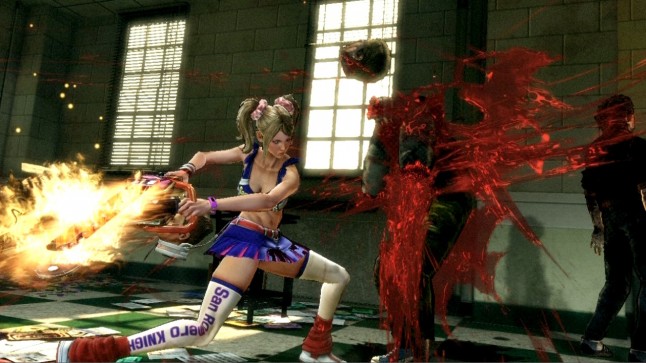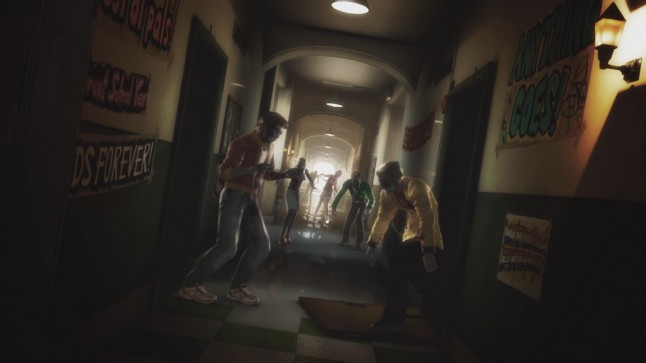This post has not been edited by the GamesBeat staff. Opinions by GamesBeat community writers do not necessarily reflect those of the staff.
Suda51’s Grasshopper Manufacturing is known for designing juvenile and campy games, the title of Lollipop Chainsaw perfectly exhibits this quality.
Lollipop Chainsaw’s ridiculous motif doesn’t stop at the title. The game stars blonde, high school cheerleader, Juliet Starling, who comes from a family of zombie hunters. She is accompanied by a heart embedded chainsaw, and the living, decapitated head of her boyfriend. The strength of Lollipop Chainsaw is that it knows it’s ridiculous. It knows, and embraces it.
Those familiar with Grasshopper Manufacturing’s No More Heroes series will find numerous similarities between the two titles. Both feature a protagonist wielding an anomalous weapon, spouting obscenities and tearing through enemies in style. From a gameplay standpoint, they play very much the same. Mash buttons, defeat enemies, and watch the blood pour across the screen.

Unlike Dynasty Warriors, and similar games, you can’t rely on button mashing. Stringing together combos is essential in Lollipop Chainsaw, but executing combos takes a while to get right. The combinations are easy enough, but there is a bit of latency between the controller and game that will take some getting used to. Using strategy is equally as important, as going in for a head-on assault will cause you to get knocked around. Dodging and waiting for your opening is the best way to take out groups of zombies. Planning ahead will also make it easier to kill three or more zombies with the same attack (which the game refers to as “sparkle hunting”) – which will greatly increase the in-game currency you get from the kills, allowing you to purchase more combos, upgrades and costumes.
The levels in Lollipop Chainsaw are setup very linear and don’t allow you to explore the apocalyptic environment very much. You are basically presented with task after task (usually involving a generic kill 10 zombies to move on stipulation), and can only move on after a successful try. These missions seem pretty generic and repetitive at first, but as the game goes on, they branch out and diversify. Mini-games appear, and usually stick to the theme of the level. For instance, while fighting through a gymnasium, you enter a game of zombie basketball where decapitating heads arch through the air and into the basket, scoring points. Likewise, when brawling through an arcade, retro-style mini-games will prevent you furthering your progress until beaten.

At the end of a level, you will encounter a boss, which is pretty much par for the course in videogames. However, the boss fights are surprisingly diverse from other games, as well as from boss to boss. The closest comparison would probably be the bosses from the No More Heroes franchise. Each boss has a distinct strategy to be defeated, as well as multiple stages to do so. Surprisingly, and thankfully, they deviate away from the do-this-three-times-to-defeat-the-boss tactic that is lazily stuck in so many games, making the experience all the more enjoyable.
While the gameplay is fun, it does suffer from a few flaws – most notably stiff controls and camera issues. Turning and changing directions gets a bit wonky while playing and doing so will also shift the camera to try and keep you facing forward. While it’s a good thought, it doesn’t work well and requires the camera to be adjusted manually, which forces you to stop and wait while it sluggishly creeps towards its destination.
While the game is somewhat forgiving with checkpoints, and also quite liberal with lollipops (which can be used to heal Juliet), there are points where it becomes brutal to make mistakes. Failing a mini-game means starting again from the beginning, sometimes requiring you to view a lengthy cutscene. When stuck in a loop of failure stretching 10+ tries, this can become tiresome –especially since the cutscenes can’t be skipped.
Suda51's games are generally known to be obscene and off-the-wall crazy, but possessing a compelling story too. With Hollywood writer James Gunn onboard to work with Lollipop Chainsaw’s story, it gave me high hopes. Sadly, the narrative is simple and weak; with the quality falling below that of Suda51’s other works. It’s disappointing that Suda51 and Gunn couldn’t craft something a little more compelling.

That being said, story is not the reason to love this game. If anything, the weak story might even work to emphasize how zany the rest of the game is. You’re a cheerleader who is fighting your high school classmates, who have become zombies, with a chainsaw that sprouts hearts and rainbows when you kill them. And after each level, you encounter a boss representing a genre of music. It doesn’t even try to stay within the lines of realism, and that’s why it’s so appealing.
The dialogue and soundtrack help to amplify the absurd nature of Lollipop Chainsaw even further. Juliet and her boyfriend, Nick, will discuss random, humorous topics that keep you entertained while you play – there is never a dull moment in Lollipop Chainsaw. Some of the funniest discourse will come from the zombies, though. When killed, they will shout hilarious phrases, sometimes professing their love for you.
The soundtrack, which is a mix of 80’s rock and peculiar songs, completes the game and gives it soul. You will hear anything from “Mickey” and “You spin me round” to a song paying homage to the Ninja Turtles. It captures the mood and theme of the game perfectly, and Lollipop Chainsaw honestly wouldn’t be the same without it.
Closing comments:
Some games are great because they tell a mesmerizing story; some are recognized as being artistic; and others inspire a change in the industry. Lollipop Chainsaw does none of these, but is enjoyable based solely on how bizarre it is. The controls could use a bit more polish, which holds the game back, but the humor and fun pick up the slack when the gameplay is stalling. All in all, Lollipop Chainsaw provides an experience that simply can’t be found in any other game.
